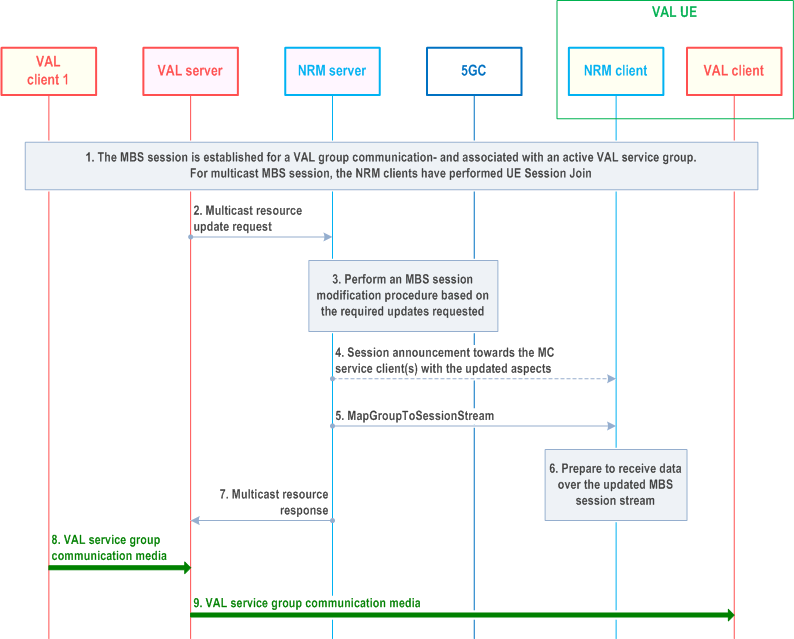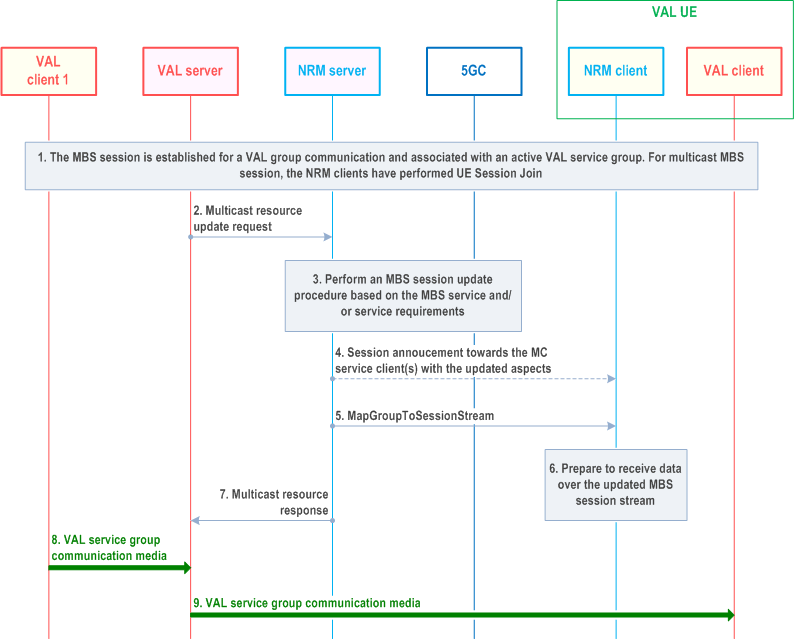Content for TS 23.434 Word version: 19.3.0
0…
4…
5
6…
6.4…
6.5…
6.5.3…
7…
8…
8.2.2…
9…
9.3…
9.3.2.21…
9.3.3…
9.3.6…
9.3.11…
9.3.13…
9.3.14…
9.4…
9.4.6…
9.5…
10…
10.3…
10.3.2.22…
10.3.3…
10.3.7…
10.3.10…
10.4…
11…
11.3…
11.3.3…
11.4…
12…
12.3…
13…
14…
14.2.2.2…
14.3…
14.3.2.20…
14.3.2.40…
14.3.3…
14.3.3.3…
14.3.4…
14.3.4.6
14.3.4.7…
14.3.4A…
14.3.4A.3…
14.3.4A.4…
14.3.4A.6…
14.3.4A.8…
14.3.4A.9…
14.3.4A.10…
14.3.5…
14.3.6…
14.3.9…
14.3.12…
14.4…
15…
16…
17…
18…
A
B…
14.3.4A.3 MBS resources update
14.3.4A.3.1 General
14.3.4A.3.2 Procedure for updating MBS resources without dynamic PCC rule
14.3.4A.3.3 Procedure for updating MBS resources with dynamic PCC rule
...
...
14.3.4A.3 MBS resources update p. 235
14.3.4A.3.1 General p. 235
The VAL server can create one or several MBS sessions via the NRM server, based on certain service requirements, a certain service area, or the activity status of multicast MBS sessions. However, during the life cycle of the MBS sessions, the VAL server may need to trigger the update of the sessions via the NRM server to meet emerging needs, including the service requirements, service area related parameters.
14.3.4A.3.2 Procedure for updating MBS resources without dynamic PCC rule p. 235
The procedure shown in Figure 14.3.4A.3.2-1 presents an MBS session update procedure triggered by the VAL server via the NRM server (either directly interacting with the MB-SMF, or indirectly with NEF/MBSF). Within the update request, either the service requirements, MBS service area, activity status of multicast MBS session, or all three are done, as indicated in TS 23.247.
Pre-conditions:
- The NRM clients 1 to n are attached to the 5GS, registered and belong to the same active VAL service group.
- The NRM server has obtained the required information related to the MB-SMF, either locally configured or during initial session configuration.
- The MBS session is created with certain service requirements and optionally with a certain broadcast/multicast service area. The MBS session is announced to be associated with the VAL service group for group communication purposes.

Step 1.
An MBS session is established as described in in TS 23.247 (either a multicast or a broadcast session), and associated with a certain active VAL service group for group communication purposes. In the case of a multicast MBS session, the NRM clients have already joined the session.
Step 2.
The VAL server invoke the multicast resource update request to the NRM server once the need has emerged to modify some aspects for the given MBS session under consideration. The updated parameters are included, e.g., service requirements, service area or both. In case of multicast MBS sessions, the VAL server may as well include the status (active or inactive) of the multicast MBS session to be set.
Step 3.
The NRM server performs an MBS session update procedure with the 5GC as described in 3GPP 23.247 [39]. Based on the needed requirements, the corresponding MBS session is accordingly modified at the 5GS. The update may lead to QoS Flow(s) addition, modification, or removal. The NRM server receives an MBS session update response once the requested modifications are performed, and the indicated MBS session is updated accordingly.
Step 4.
The NRM server may initiate a session announcement towards the NRM clients associated with the ongoing session in order to announce the updated information, if required, e.g., the updated service area or SDP information.
Step 5.
The NRM server sends an MapGroupToSessionStream over the configured MBS session providing the required information to receive the media related to the established VAL service group communication.
Step 6.
The NRM clients process the received information over the MapGroupToSessionStream in order to receive the associated VAL media over the specific MBS session stream.
Step 7.
The NRM server returns the multicast resource update resonse to the VAL server.
Step 8.
VAL client 1 sends media to the VAL server over unicast to be distributed for the established group communication.
Step 9.
The VAL server distributes the VAL media to the VAL clients 2 to n over the indicated streams.
14.3.4A.3.3 Procedure for updating MBS resources with dynamic PCC rule p. 237
The procedure shown in Figure 14.3.4A.3.3-1 presents an MBS session update procedure triggered by the NRM server to the 5GC, either directly or via NEF/MBSF. Based on the required updates to be done, the NRM server needs to interact with the MB-SMF to update the MBS service area and multicast activity status, with the PCF to update the required QoS requirements, or sequentially both to update all the above, as indicated in TS 23.247.
Pre-conditions:
- The NRM clients 1 to n are attached to the 5GS, registered and belong to the same active VAL service group.
- The NRM server has obtained the required information related to the MB-SMF, either locally configured or during initial session configuration.
- The MBS session is created with certain service requirements and optionally with a certain broadcast/multicast service area. The MBS session is announced to be associated with the VAL service group for group communication purposes.

Step 1.
An MBS session is established as described in TS 23.247 (either a multicast or a broadcast session), and associated with a certain active VAL service group for group communication purposes. In the case of a multicast MBS session, the NRM clients have already joined the session.
Step 2.
The VAL server invoke the multicast resource update request to the NRM server once the need has emerged to modify some aspects for the given MBS session under consideration. The updated parameters are included, e.g., service requirements, service area or both.
Step 3.
The NRM server, based on the update requirements from step 2, perform the MBS session update with PCC procedure towards the 5GS as described in TS 23.247.
Step 4.
The NRM server may initiate a session announcement towards the NRM clients associated with the ongoing session in order to announce the updated information if required, e.g., the updated service area or SDP information.
Step 5.
The NRM server sends an MapGroupToSessionStream over the MBS session providing the required information to receive the media related to the established VAL service group communication.
Step 6.
The NRM server returns the multicast resource update resonse to the VAL server.
Step 7.
The NRM clients process the received information over the MapGroupToSessionStream in order to receive the associated VAL media over the specific MBS session stream.
Step 8.
VAL client 1 sends media to the VAL server over unicast to be distributed for the established group communication.
Step 9.
The VAL server distributes the VAL media to the VAL clients 2 to n over the indicated streams.